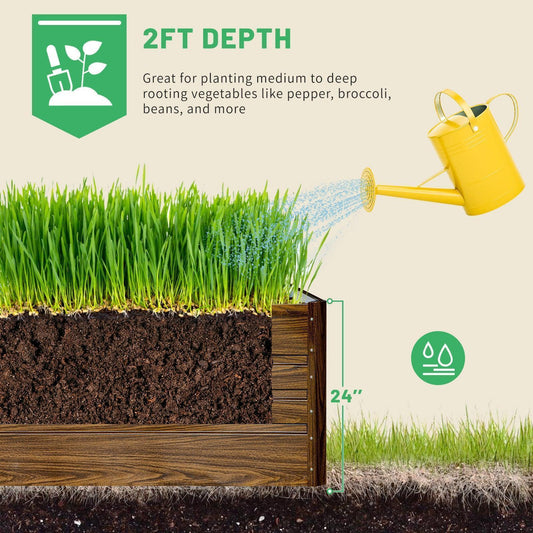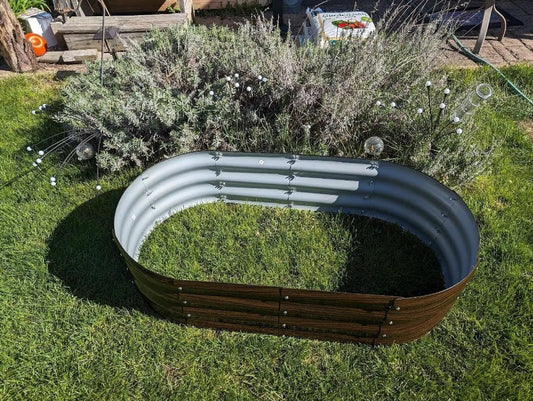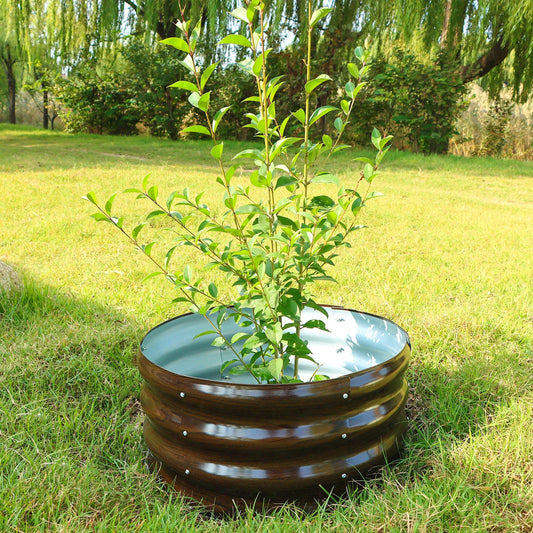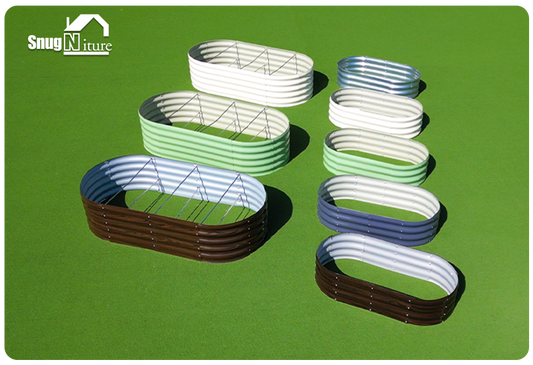How to choose height for vegetable gardening and best metal materials
You want your raised garden to thrive, so choosing the perfect height and sturdy materials matters. Most gardeners find that a raised garden bed between 17 and 32 inches works great for vegetables. Galvanized steel and powder-coated metal last over 20 years, even outdoors. These raised garden beds stand up to rust and keep your plants safe. If you want to choose height for comfort or to match what you grow, you get plenty of options. You can build a raised garden that fits your space and style.
Key Takeaways
-
Pick a raised garden bed height from 17 to 32 inches. This height works well for most vegetables.
-
Match the bed height to how deep your plants’ roots grow. Plants with shallow roots need 6 inches. Root crops need 12 inches. Big plants like tomatoes need 18 inches or more.
-
Use galvanized or powder-coated steel for your raised beds. These materials last a long time and do not rust. They can last over 20 years outside.
-
Make raised beds 24 to 36 inches tall for easy gardening. This helps you garden without bending too much. It is good if you have back pain or use a wheelchair.
-
Plan your garden with sunlight, paths, and tall structures. This makes your garden pretty, easy to use, and helps plants grow well.
Choose Height for Raised Garden Bed

Ideal Height Range
When you start planning your raised garden bed, you want to choose height that fits your space and your needs. Most gardeners find that a raised garden bed between 17 and 32 inches gives the perfect height for growing vegetables and fruits. This range works well for most plants and makes gardening easier for you.
A raised garden bed that stands at least 12 inches tall gives your plants enough soil depth for strong roots. If you want to grow a mix of vegetables, herbs, and fruits, you can pick a height in the middle of this range. Many people like a raised garden bed that is about 24 inches high. This height lets you reach your plants without bending too much and gives your garden a neat look.
Tip: If you want to keep small animals out of your garden, a taller raised garden bed helps protect your plants.
Height for Different Vegetables
Not all plants need the same soil depth or raised garden bed height. Some vegetables have shallow roots, while others need more room to grow. You want to choose height based on what you plan to grow. Here’s a quick guide to help you match the perfect height to your favorite vegetables and fruits:
|
Plant Type |
Recommended Raised Garden Bed Height |
Reasoning |
|---|---|---|
|
Herbs and small leafy greens |
6 inches |
Shallow root systems require minimal depth |
|
Root crops and larger leafy greens |
12 inches |
Deeper roots need more soil depth |
|
Larger fruiting plants (e.g., tomatoes, eggplants) |
18 inches |
Extensive root growth requires deeper soil |
|
General aesthetic/ergonomic preference |
Up to 24 inches (2 feet) |
Provides ease of tending and visual appeal |
You can see that leafy greens like lettuce or spinach do well in a raised garden bed with just 6 inches of soil depth. Root crops such as carrots or beets need at least 12 inches. If you want to grow tomatoes or other fruits, you should choose a raised garden bed that is at least 18 inches tall. This gives your plants plenty of soil depth for healthy roots and strong growth.
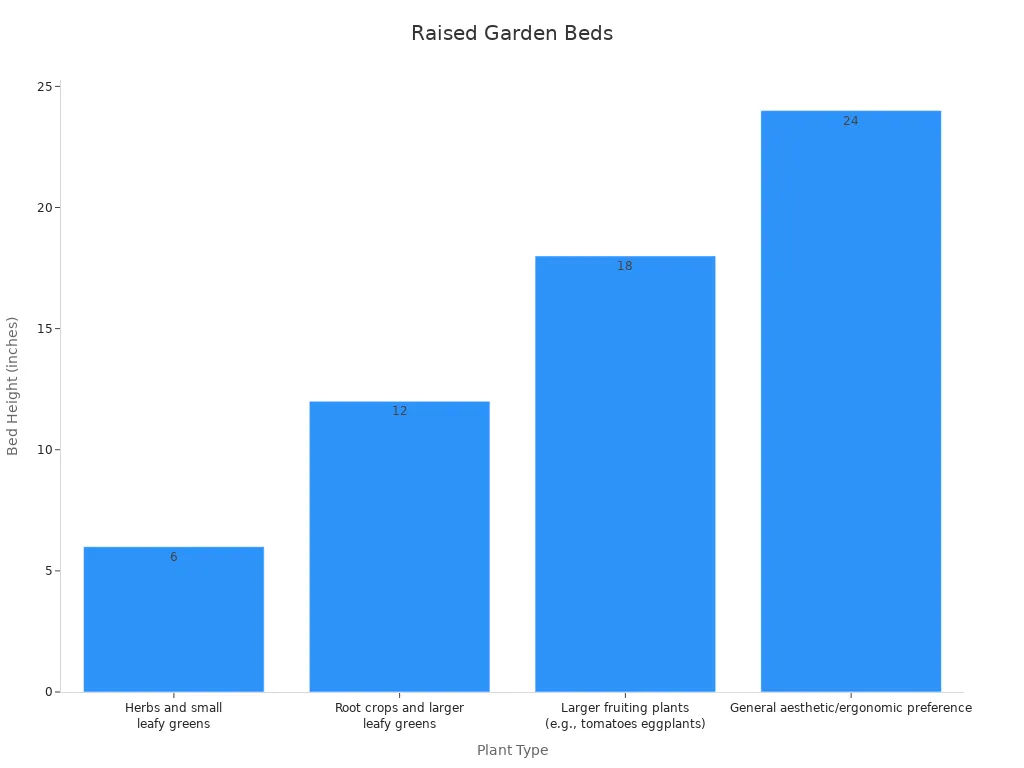
If you plan to grow a mix of vegetables and fruits, you can build beds of different heights or use a deeper bed for everything. This way, you make sure every plant gets the soil depth it needs.
Note: If your raised garden bed sits on concrete or another hard surface, you need to make it deeper—at least 24 to 36 inches. This extra height gives your plants enough soil depth since their roots cannot reach the ground below.
Ergonomic Height Options
You want gardening to feel easy and fun, not like a chore. The perfect height for your raised garden bed depends on your comfort. Many gardeners choose height between 24 and 30 inches for the best experience. This height lets you tend your plants without bending or kneeling, which helps if you have back pain or trouble moving.
Ergonomic studies show that a raised garden bed at 24 to 36 inches high reduces strain on your back and knees. You can reach your plants easily, and you spend less time weeding. If you use a wheelchair or want to garden while sitting, you might prefer a raised garden bed up to 36 inches tall. This makes gardening more accessible and enjoyable for everyone.
You can test different heights by stacking boxes or using a table. Find the perfect height that feels right for you. Remember, the best raised garden bed height is the one that matches your needs and helps you enjoy gardening every day.
Pro Tip: A raised garden bed with a width of 2 to 3 feet lets you reach all your plants without stretching too far. This makes planting, watering, and harvesting much easier.
Raised Bed Gardening: Why Height Matters
Root Depth and Plant Health
You want your garden to grow strong, healthy plants. The height of your raised garden bed plays a big role in this. When you match the height of your raised bed to the root depth of your plants, you give them the best chance to thrive. Different plants need different soil depth to grow well.
-
Shallow-rooted plants like herbs and lettuce do fine with just 6 inches of soil depth in your raised garden.
-
Root vegetables, peppers, and strawberries need at least 12 inches of soil depth for their roots to spread.
-
Tomatoes, eggplants, and squashes need a raised garden bed that is at least 18 inches high because their roots grow deeper.
-
Some plants, such as asparagus, need up to 36 inches of soil depth for the best results.
If you plant in soil that is too shallow, your plants may not grow well. They can become weak and unstable. You want to make sure your raised garden bed height matches the needs of your plants. This helps your garden stay healthy and productive, whether you grow vegetables, fruits, or flowers.
Drainage and Soil Volume
Good drainage keeps your garden healthy. When you use raised bed gardening, you lift the soil above the ground. This helps water move through the soil better. A higher raised garden bed gives you more soil volume, which means your plants have more room for their roots.
Studies show that even a small increase in height, like from 6 to 8 inches, can boost your garden’s crop yield. More soil depth means better water retention and more space for roots to grow. Raised beds with greater height also drain faster, so your plants do not sit in soggy soil. The Virginia Cooperative Extension explains that raised beds improve drainage by letting gravity pull water down and away from your plants.
You want to choose the right height for your raised garden bed to keep your plants happy. More soil depth means healthier roots, better drainage, and a more productive garden. Raised bed gardening makes it easier to control these factors and grow the best plants possible.
Raised Garden Bed Materials
Best Metal Options
When you pick a raised garden bed, you want it to last for years. Metal is a top choice for many gardeners because it stands up to weather and looks neat in your yard. Galvanized steel is one of the best options for a raised garden bed. You get a strong, rust-resistant frame that can last up to 30 years. This material is affordable and easy to recycle when you want to change your garden design.
You might also see powder-coated steel beds. These have a special coating that protects the metal from scratches and chips. Powder-coated metal keeps your raised garden bed looking new, even after years of sun and rain. Corrugated galvanized steel gives extra strength and stays lightweight, so you can move your raised garden bed if you need to.
Aluminum is another good choice for a raised garden bed. It does not rust and works well outdoors. Some raised garden beds use aluminum corners with powder coating for extra durability and a tidy look. When you choose metal, check for smooth edges. Some metal beds have sharp corners, so you want to make sure your raised garden bed is safe for everyone.
Here’s a quick list of top metal options for your raised garden bed:
-
Galvanized steel: Long-lasting, rust-resistant, affordable
-
Powder-coated steel: Extra protection, keeps color and finish
-
Corrugated galvanized steel: Strong, lightweight, easy to move
-
Aluminum: Rust-proof, clean look, good for corners
Tip: If you live in a hot climate, metal beds can heat up fast. Place your raised garden bed where it gets some shade during the hottest part of the day.
Durability and Maintenance
You want your raised garden bed to stay strong year after year. Galvanized steel stands out because it resists rust and weather. Farmers have trusted galvanized steel for generations, so you know it works. The galvanizing process covers the steel with a layer of zinc, which keeps water and air away from the metal. This means your raised garden bed will not rust, even in wet weather.
Powder-coated metal gives even more protection. The coating bonds to the metal and stops chips and scratches better than paint. If you want a raised garden bed that looks good and lasts, powder-coated steel is a smart pick. Corrugated galvanized steel adds strength without making your raised garden bed heavy. You can move it if you want to change your garden layout.
Aluminum is another durable choice. It does not rust, so you do not have to worry about rain or snow. When you use powder-coated corners, your raised garden bed stays neat and tidy. You do not need to spend much time on maintenance. Just check your raised garden bed once in a while for dents or scratches. Wipe it clean if you see dirt or leaves. That’s it!
Note: Metal beds last longer than wood, but they can get hot in the sun. If you live in a warm area, add mulch or plant tall crops to shade the soil in your raised garden bed.
Alternatives to Metal
You have many choices when it comes to raised garden bed materials. Metal is strong and lasts a long time, but you might want a different look or feel for your garden. Wood, stone, and synthetic materials all work well for raised garden beds. Each one has its own pros and cons.
Here’s a table to help you compare different raised garden bed materials:
|
Material |
Advantages |
Disadvantages |
|---|---|---|
|
Wood |
Natural look, easy to find, rot-resistant types last longer, can be upcycled, cheaper option |
Untreated wood rots faster, treated wood may leach chemicals, some types unsafe for food crops |
|
Stone |
Natural, eco-friendly if local, adds nutrients as it breaks down, can be stacked |
Heavy, expensive if not local, hard to move, can be unstable on loose soil, needs upkeep |
|
Synthetic |
Durable, low maintenance, easy to set up, raised beds on legs help with access |
May not hold moisture as well as natural materials |
|
Metal (Steel) |
Durable, thin sides save space, lasts 20+ years with coatings, affordable, easy to assemble |
Untreated steel can rust, may leach chemicals, some types corrode in acidic soils, can stain surfaces |
Wood gives your raised garden bed a classic look. Cedar and redwood last longer and resist rot. Stone looks natural and adds nutrients to your garden soil. Synthetic beds, like plastic or resin, are easy to set up and need little care. Raised beds on legs make gardening easier if you want to avoid bending.
When you choose materials for your raised garden bed, think about your climate, your budget, and the style you want for your garden. Pick the raised garden bed that fits your needs and helps your plants grow strong.
Design Tips for Raised Bed Gardening
Layout and Aesthetics
You want your raised garden to look great and work well. Start by planning your layout before you build. Place your raised beds where they get at least six hours of sunlight each day. Arrange them to create clear paths so you can walk around and reach every plant. Paths also keep you from stepping on the soil, which helps your plants grow better.
Many gardeners use vertical gardening to save space and add beauty. You can add trellises, arches, or even a vertical herb garden near your kitchen door. These features turn fences or small corners into productive and attractive spots. Try mixing vegetables with flowers in your raised beds. This makes your garden look like living art and can help with pest control. Use color to your advantage—pair green leafy vegetables with red tomatoes or purple basil for a stunning effect.
Here are some popular design ideas:
-
Combine ornamental plants with vegetables for a colorful look.
-
Use vertical structures to create shade and maximize your garden space.
-
Try companion planting, like tomatoes with basil, for both beauty and better growth.
Biophilic landscaping is a trend that brings nature closer to your home. Arrange your raised beds with fruits, herbs, and vegetables in a way that feels peaceful and inviting. This approach helps you enjoy your garden every day.
Accessibility Features
You can make your raised garden easy for everyone to use. Build your raised beds at a height that feels comfortable. Many gardeners choose beds between 24 and 36 inches tall. This height lets you garden without bending or kneeling, which is great if you have back pain or use a wheelchair.
Keep your beds no wider than four feet. This way, you can reach the middle from either side without stretching. Add benches along the edges for a place to sit while you work. Raised beds also help keep weeds down and make watering easier, especially if you use mulch or a drip system.
Here are some tips for an accessible raised garden:
-
Build beds at least 8 to 12 inches high for good drainage.
-
Use quality soil mixes to reduce the need for watering and weeding.
-
Make sure paths are wide and smooth for easy movement.
-
Place your raised beds close to your house or water source for convenience.
Raised beds warm up faster in spring and drain better after rain. This gives you a longer growing season and healthier plants. By planning your raised garden with accessibility in mind, you create a space that everyone can enjoy and maintain with less effort.
You want your raised garden bed to fit your garden and your needs. Match the height of your raised garden bed to the vegetables you grow. Deeper beds work best for plants with long roots, like squash or tomatoes. Galvanized water troughs make a sturdy, long-lasting choice for your raised garden bed. For your next step, measure your space, list your favorite vegetables, and pick the best materials for your garden. This way, you create a raised garden bed that lasts and helps your garden thrive.


